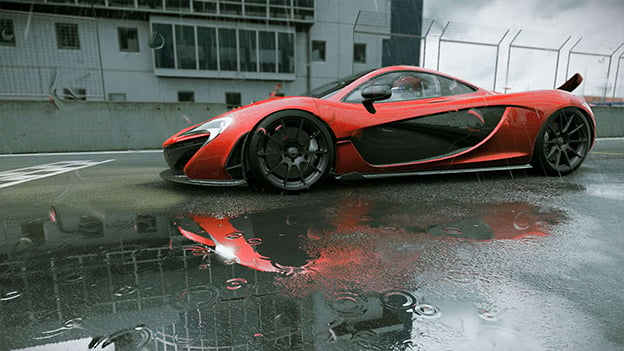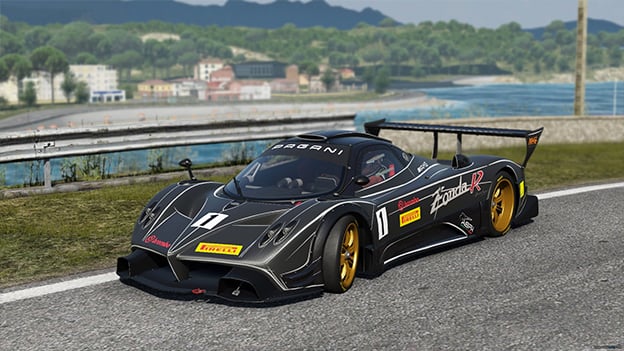Changing Your Front Left Tire Pressure By .01
The racing genre has splintered in the last several years. Outside of wacky kart racers like Mario Kart , racing now come in two varieties. By far the most common is the “racing game,” which is essentially a cracked out fantasy about cars. Here you race across country, evade police, crash into other cars that obviously have robot drivers or something, earn XP for ramping over rivers, so on so forth. Then, there is the “racing sim,” an entirely different type of beast which holds you to real cars on real tracks with real physics and asks you to master the subtle art of the turn.
Project CARS , the new game from Slightly Mad Studios and Bandai Namco, is the latter, and unapologetically so. It’s meant for serious gear heads that primarily like one thing and one thing only, cars. It eschews the trappings and innovations of modern day racing games for cars, tracks, and options. It’s built specifically for the race and preparing for the race. It knows its audience, and if you are part of that audience you will love it, but if you aren’t, it could seem rather daunting.
When the game first starts up, you are immediately given a taste of the complexity it has to offer. You are asked to choose between Novice, Amateur, and Pro racing modes to quick set most of your racing settings. Novice sets all driving assists and on screen U.I. elements to on, turns off vehicle degradation and, get this, motorsports rules. It also sets the difficulty to easy. Amateur has you automatic shifting and provides you with some assists and U.I. elements, but you’ll experience tire wear and fuel depletion and you have to abide by the rules. By the time you are racing at pro level you’ll have no onscreen guides, no assists, no help of any kind, your car will get damaged by impact and through normal wear and tear, your fuel will deplete (and that will affect your car’s performance and weight), and you have to abide by all professional motorsport rules.

And that’s only the tip of the iceberg. When you get into the game and check out the settings and your garage, you’ll notice more options than I could possibly list here while still keeping the article readable. Aside from yet more assists, effects, guides, rules, and more that you can turn on and off, you can do things like increase or decrease tire pressure on each individual tire, tweak the tension in your cars suspension, tweak your car’s aerodynamics, increase the size and weight of your fuel tank, adjust your alignment, change your break pressure, and a whole host of other options that reference mechanical terms I had to look up!
Nothing is universal here. Everything is small, detailed, and individual. If you want to tweak your car so it turns left more easily than it turns right specifically for courses with a bunch of left hand turns, you can do that. As I said before, however, this is easily intimidating for someone who isn’t a total gear head. Heck, it intimidated me. Unfortunately, this is also the biggest draw the game has to offer, so if details customization isn’t your bag, you aren’t going to find much here. On the flip side, if customization is your thing, you can spend hours making setup after setup without ever actually playing the game and still have fun.

You won’t find a single player story mode, tons of visual customization options, a leveling system, a persistent online world, stunt challenges, or even level-ups and unlocks. Everything the game has to offer you is offered from the moment you boot it up. You’ll have access to every car, every option, every track, every possible avenue of gameplay with no hoops to jump through.
Progression in the game Is, instead, rather organic. You can jump into your favorite racing model as soon as you boot up the game, but you’ll probably be running off the course simply due to the difficulty in controlling the beast. Meanwhile, if you want to start with simple kart racing, you’ll get the hang of the game’s controls more naturally.
There is a single player career mode, but even this is customizable. You can start at any level in any division with any sort of car. You can adjust your difficulty at any time, making certain circuits harder, easier, longer, or shorter. This is actually fantastic, as you can make the races you hate short and easy and the races you love long and hard. There’s no real “game end” scenario. You simply hop in, race the way you want, and hop out when you are done. You get to create a racer, but this is secondary to the cars, and you have three main goals you are asked to complete, but this too is secondary. It’s kind of like a career mode in any given sports title, but way way more open-ended. The only barriers are your own.

Project CARS is a game that absolutely begs to be played with a racing wheel setup. It does its best to be welcoming if you are playing with keyboard and mouse or a gamepad, but both of these options are sorely lacking in giving you the full racing experience. You can tweak your controls and options, futzing around with your dead zones on your stick, but with a racing wheel you even get to screw around with force feedback, so it actually feels as if the wheel is tugging at you as you take sharp turns. Of course, that creates yet another barrier to entry in the form of the cost of a racing wheel.
To be honest, it’s these barriers that hinder Project CARS the most. Many modern day games hold your hand from beginning to end, but Project CARS asks you to have your own fun. Want to run time trials against yourself? You can do that. Want to race in 24 player online races? You can do that. Want to race for literally hours upon hours in just one race? You are crazy, but you can do that. The most Project CARS does is offer you challenges here and there to break up the single-player mode, but aside from that, you have to decide what you want to do, and do it. I know that I, more than once, found myself lacking motivation to continue on simply because I didn’t want to futz with options again, but at that point I had already spent several hours on the game without even knowing it.
In short, Project CARS is a racing game that has everything, but doesn’t necessarily appeal to everybody. It’s hard to fault the game in any particular way. It runs well, looks gorgeous, and does exactly what it advertises, which is a lot, but nothing more. I wouldn’t call it a breakthrough in racing design, but rather a refinement of the racing sim formula. It knows what it is, and knows what its audience is. If you are part of that audience, definitely give it a look. It’s probably the best racing sim on the market right now. Just know that it’s meant to appeal to hardcore gear heads first and foremost, and people looking for a more casual racing experience should probably look elsewhere.
RATING OUT OF 5 RATING DESCRIPTION 4.5 Graphics
It’s an absolutely gorgeous game, from weather effects to detailed car interiors. 3.9 Control
With a racing wheel, this game is gold. Without, you’ll find yourself struggling to get used to the controls even with racing assists on, but that’s part of the fun. 4.0 Music / Sound FX / Voice Acting
I really like the announcer and the epic music. Some might find the orchestral scores on the menu out of place, but I find them fitting. There is something zen about tweaking your cars to classical music. 4.0 Play Value
The replay value of this game is solely dependent on you. It’s very easy to lose yourself in the sea of options the game presents you with, but only if you know how to make your own fun. 4.1 Overall Rating – Great
Not an average. See Rating legend below for a final score breakdown.
| Review Rating Legend | |||
|---|---|---|---|
| 0.1 – 1.9 = Avoid | 2.5 – 2.9 = Average | 3.5 – 3.9 = Good | 4.5 – 4.9 = Must Buy |
| 2.0 – 2.4 = Poor | 3.0 – 3.4 = Fair | 4.0 – 4.4 = Great | 5.0 = The Best |
Game Features:
